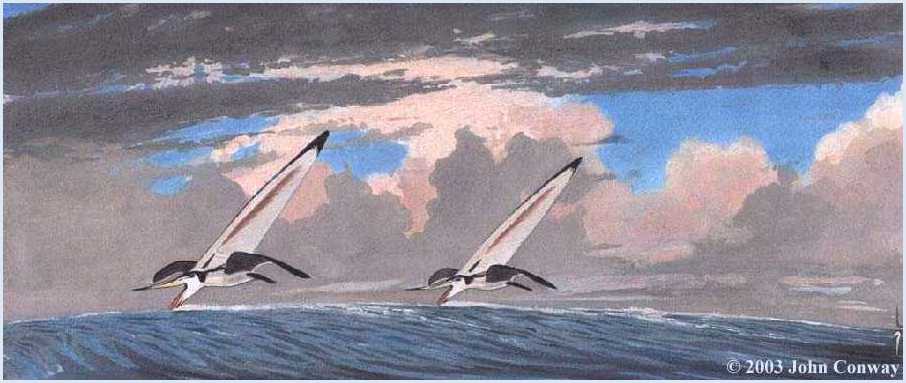
Detail of skimming Nyctosaurs painting © 2003 by John Conway. Used with permission of John Conway. Click on picture to enlarge.
Marsh, O. C., 1876.
Principal characters of American pterodactyls.
American Journal of Science, Series. 3,
12(72):479-480.
Wherein O. C. Marsh describes some characteristics of the various newly discovered species of Pteranodons, and names a new species, Nyctosaurus gracilis, from the Smoky Hill Chalk of western Kansas.
| APPENDIX. __________________ ART. L. ---Principal Characters of American pterodactyls;* by Professor O. C. MARSH. THE remains of Pterosauria or flying lizards, hitherto found in this country, are all from the Upper cretaceous deposits of Kansas. They are remarkable for their large size, some having a spread of wings not less than twenty-five feet. They differ widely from the Pterodactyls of the old world, especially in the absence of teeth and hence have been placed by the writer in a new order, Pteranodontia §, from the typical genus Pteranodon. In this genus, the skull is much elongated. The orbits, and the antorbital and nasal apertures are large. The maxillary and premaxillary bones are coossified, and entirely edentulous. The atlas and axis are united. The scapular arch presents some peculiar features, not before known in any vertebrate. The scapula, which is firmly coossified with the coracoid, has at its distal end an oblique articular face. This articulation is separated from the cor- responding facet of the opposite scapula by a thin median plate, which is apparently a neural spine of a dorsal vertebra. The two scapulę thus brace each other, and aid in securing powerful flight. In Pteranodon the fourth finger is greatly elongated, and the wing metacarpal is longer than half the antebrachium, There are five separate carpal bones, beside the pteroid bone which supported the membrane. The pteroid is not a true carpal, but is perhaps homologous with the small bone in the foot of a bat which supports the patagium. The first three metacarpals are very slender, pointed above, and do not reach the carpus. At their distal end they supported sharp, curved claws. In some species, the distal phalanx of the wing finger is not straight, but falciform. The pelvis in Pteranodon is of moderate size. The ilia are elongate and the acetabulum is imperforate. The ischia are broad, and united on the median line. The tail is short and slender, and the distal caudals are sometimes coossified. The posterior limbs are well developed. The tibia has at its distal end a pulley-like articular surface. There are two tarsal bones of nearly equal size, * Abstract of a paper read before the American Association for the Advancement of Science, at Buffalo, Aug. 28th, 1876. § This Journal, vol. xi, p. 507, June, 1876. 480 O. C. Marsh -American Pterodactyls. and a small lateral bone, which may possibly be the distal end of the fibula. There are four metatarsals of nearly the same length, and their ungual phalanges are pointed, but not much curved. The known species of Pteranodon are as follows: Pteranodon occidentalis Marsh (Ornithochirus harpyia Cope), Pteranodon ingens Marsh (Ornithochirus umbrosis Cope), Pteranodon velox Marsh, Pteranodon longiceps Marsh, and Pteranodon comptus Marsh. Nyctosaurus, gen. nov. A second genus of American Pterodactyls is represented in the Yale Museum by several well preserved specimens. This genus is nearly related to Pteranodon, but may be readily distinguished from it by the scapular arch, in which the coracoid is not coossified with the scapula. The latter bone, moreover, has no articulation at its distal end, which is comparatively thin and expanded. The type of this genus is Pteranodon gracilis Marsh, which may now be called Nyctosaurus gracilis. It was a Pterodactyl of medium size, measuring about eight to ten feet between the tips of the expanded wings. Its locality is in the upper Cretaceous of Western Kansas. The type specimens of all the above species are preserved in the Museum of Yale Col1ege. |
Marsh, O. C., 1871. Note on a new and gigantic species of Pterodactyle. Amer. Jour. Sci. ser. 3 1(6):472.
Marsh, O. C., 1872. Discovery of additional remains of Pterosauria, with descriptions of two new species. Amer. Jour. Sci. ser. 3, 16:241-248.
Marsh, O. C., 1876. Recent discoveries of extinct animals. Amer. Jour. Sci. ser. 3, 12(67):59-61.
Marsh, O. C., 1876. Principal characters of American pterodactyls. Amer. Jour. Sci. ser. 3, 12(72):479-480.
Williston, S. W., 1891. The skull and hind extremity of Pteranodon. Amer. Nat. 25(300):1124-1126.
Williston, S. W., 1892. Kansas pterodactyls. Part I. Kansas Univ. Quarterly 1:1-13, pl. i.
Williston, S. W., 1893. Kansas pterodactyls. Part II. Kansas Univ. Quarterly 2:79-81, with 1 fig.
Williston, S. W., 1895. Note on the mandible of Ornithostoma. Kansas Univ. Quarterly 4:61.
Williston, S. W., 1896. On the skull of Ornithostoma. Kansas Univ. Quarterly 4(4):195-197, with pl. i.
Williston, S. W., 1897. Restoration of Ornithostoma (Pteranodon). Kansas Univ. Quarterly 6:35-51, with pl. ii.
Williston, S. W., 1902. On the skeleton of Nyctodactylus, with restoration. Amer. Jour. Anat. I 297-305.
Williston, S. W., 1902. On the skull of Nyctodactylus, an Upper Cretaceous pterodactyl. Jour. Geol. X 520-531, 2 pls.
Williston, S. W., 1903. On the osteology of Nyctosaurus (Nyctodactylus), with notes on American pterosaurs. Field Mus. Publ. (geol. Ser.) 2(3):125-163, 2 figs., pls. XL-XLIV.